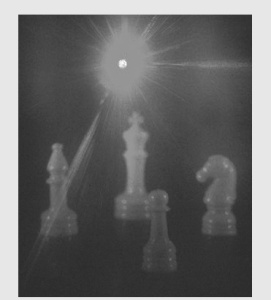How is a hologram made? The light from a laser is used to illuminate some chess pieces in a certain way and a piece of photographic film is exposed to the reflected light as in the diagram below.

After the film is developed, in its transparent form, it looks like this picture under ordinary light, in other words, it looks like a nice pattern of swirls like water waves set up by a rock dropped into a pool of quiet water.
But if the film is exposed to the same laser light that was used to make the exposure, then looking through the film like a window, with the laser light diffused so that it doesn’t harm the eye, you can see the original chess pieces as if they are placed behind the “window”.
The next image shows what happens as you move your head to the left and then to the right as you look “through the window”, and you can see the chess pieces shift around just like they were really sitting there. In other words, the hologram is producing a 3-dimensional image of the original chess pieces. 
Lots of science-fiction movies simulate what 3-d holograms can do in transmitting messages to look like the person is really present, floating in midair. And there have been recent advances in trying to do this, but the best so far is being able to produce an image that seems to hover in front of a screen, but not really floating in the space like Princess Leia in the first Star Wars movie. And the image can only be seen from a limited range of angles in front of the projection.
Seeing Jesus
There are a couple of ways that this science discovery has analogies in the spiritual realm. First of all, the image cannot be seen without special light, at least with this type hologram (there are such things as “white” light holograms that can be seen in normal light).
And as mentioned several times in the New Testament, it takes the special light of the Holy Spirit to understand the good news about Jesus, and to even be able to come to him and be born again.
The most interesting feature to me of holograms is how you can cut the film into a bunch of pieces: for example, cut a 2″x2″ square film into sixteen 1/2″ x 1/2″ little squares and each piece will still have a complete picture. Each little square, when illuminated by the laser light will show all the chess pieces just like the picture above, but from different angles, different perspectives.
I see in this the analogy that every believer in the Lord Jesus has a unique perspective on the Lord, a different set of experiences and revelations about Him, that only he or she has seen. And to get the total picture of our Lord, then it takes all of the stories of all the saints (God calls all believers saints) to complete the portrait of Jesus.
As the end of John’s gospel says, “Now there are also many other things that Jesus did. Were every one of them to be written, I suppose that the world itself could not contain the books that would be written.”
——–
The images and ideas for this article were borrowed from my long-time friend and Ga. Tech. college mate, Rod Nave, from his popular web site that describes all of the many areas of physics: Hyperphysics of Georgia State University. They are used by his permission.



I have a pic of Jesus looking at me and if I move one way his eyes watch and if I move the other way he watch’s me.
I took it to the frame shop and they really messed the pic up and I wanted to know if I could find another one please help me.
Pequitta Crabtree
928-557-7607
Bixby, Oklahoma
psc22845@yahoo.com
Thank you
LikeLike
By: Pequitta Crabtree on August 31, 2022
at 6:43 pm
How would you make a hologram using your smartphone without photo chemicals?
LikeLike
By: Charles Apperson on April 15, 2016
at 11:33 pm
That’s a good question, Charlie. I’ll research that.
Laser light has two characteristics that ordinary light does not have: only one wavelength, and all the waves are synchronized (wave together at the same time and space) – that’s called coherence. That type wave is required in making a simple hologram that I described. And laser light may be required in the projection to see the 3-d image, although I remember articles talking about white light holograms. I’ll look that up as well.
A smart phone screen does not have a single point source of light like that required for the ordinary hologram – also in the chemical method I described, the film needs to be a very fine grain film to re-create the wavefronts properly. I don’t know if the pixel “grain size” is small enough on phone screens.
It seems doubtful that those requirements can be met, but who knows? I would think if it was even possible, then we would be seeing (pun intended) 3-d devices such as tv’s or computer screens that would work without special glasses that are required at present.
LikeLike
By: T. Boyd on April 18, 2016
at 3:21 pm